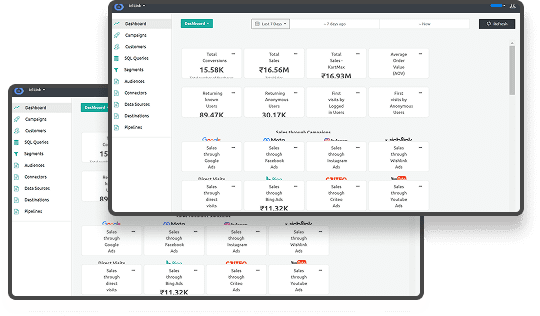The marketing world is undergoing a significant shift. Remember when we could effortlessly track users across the web with third-party cookies? Those days are rapidly fading, and this isn't just a minor change in tech—it's a fundamental transformation.
This change is driven by two major forces: consumers demanding more privacy and governments stepping in with stricter data regulations such as GDPR and CCPA. For marketers, this means rethinking attribution models—the key to understanding marketing ROI and improving campaign effectiveness.
In this article, we will compare three core attribution models—probabilistic attribution, data-driven attribution, and marketing mix modeling (MMM). We’ll explore how well each model adapts to this new, privacy-focused environment, and determine which can still deliver reliable, actionable insights while respecting user privacy and adhering to the increasingly stringent privacy laws.
The Cookieless, Privacy-Focused Landscape: What Marketers Need to Know
Before we dive into attribution models, it’s essential to understand the environment in which marketers are operating today. So, what does a "cookieless" world and stricter privacy laws mean for marketers?
- The End of Third-Party Cookies: Third-party cookies, which have long been the foundation of online tracking, are being phased out. Browsers are blocking them, and consumers are becoming more aware of their privacy rights. As a result, it’s no longer possible to track individual users in great detail, making traditional attribution methods more challenging.
- Stricter Privacy Regulations: Laws like GDPR, CCPA, and others now give people more control over their personal data. Companies must get explicit consent from users to collect their data, be clear about how it's used, and limit the data they gather. These regulations directly impact how marketers can collect and use data for attribution.
- The Shift to Aggregated and Anonymized Data: To comply with privacy regulations, marketers are moving towards data aggregation and anonymization. This means that attribution models now need to work with less granular, privacy-friendly data. It’s no longer about tracking individual users—marketers must focus on identifying broader trends and patterns.
- First-Party Data is Now Key: Data that is collected directly from customers, such as website interactions or CRM data, is becoming increasingly valuable. Not only is it compliant with privacy laws, but it is also essential for effective attribution. Marketers must focus on maximizing the use of this first-party data to continue driving insights.
- Emerging Privacy-Preserving Technologies: New technologies like differential privacy, federated learning, and secure multi-party computation offer promising ways to analyze data and perform attribution while minimizing privacy risks. These technologies could play a significant role in the future of privacy-compliant marketing.
- Navigating Legal Challenges: The legal landscape around privacy is constantly changing. Marketers need attribution models that are flexible and adaptable enough to keep up with these shifting laws and regulations.
Attribution Model Showdown: How They Perform in a Cookieless and Privacy-Conscious World
As privacy regulations tighten and the use of third-party cookies fades, it's crucial for marketers to reassess how they measure marketing effectiveness. Let’s break down three popular attribution models—probabilistic, data-driven, and marketing mix modeling (MMM)—and see how well they perform in today's privacy-focused environment.
Probabilistic Attribution Models
Probabilistic attribution models use statistical methods to estimate the likelihood that a specific marketing touchpoint contributed to a conversion. These models rely on aggregated and anonymized data, making them highly suitable for a world with tighter privacy rules.
Why They Shine in a Privacy-Focused World
- Privacy-First at Their Core: Designed to operate with aggregated data, they reduce reliance on individual-level tracking.
- Adaptability to Data Scarcity: Even with limited data, these models identify patterns and make inferences using statistical probabilities.
- Compatibility with Privacy Tech: These models integrate well with privacy-preserving technologies like differential privacy, which allows for safe data analysis.
- Bypassing Cookie Issues: As they don’t depend on cookies or user identifiers, they’re well-suited for the cookieless era.
- Future-Proofing: With privacy laws only getting stricter, probabilistic models are in a good position for long-term success as they do not rely heavily on user-level data.
Where They Fall Short
- Less Detailed Insights: These models provide broader insights at the channel or cohort level but fall short in delivering granular insights like user-level attribution.
- Accuracy Trade-Off: Since they rely on inferences, there may be slight inaccuracies in attribution, especially for complex customer journeys.
- Complexity: Building and interpreting these models requires deep expertise in statistics and data science.
- Dependence on Data Quality: While they don't rely on user-level data, they still require high-quality aggregated data to generate actionable insights.
- Bias Risk: If the assumptions behind the data or statistical methods are biased, the results can lead to skewed attribution.
For more insights into data privacy and the cookieless future, explore our article on How Cookieless Tracking Works and Its Impact on Data Collection.
Data-Driven (Algorithmic) Attribution Models
Data-driven attribution models, powered by machine learning algorithms, learn from past conversion data and dynamically assign attribution credit based on observed patterns in customer behavior. These models continuously adapt to changing customer journeys.
Why They Shine in a Privacy-Focused World
- Adaptable and Nuanced: They can handle complex customer journeys and assign attribution based on real data, even with less user-level data.
- First-Party Data Excellence: Data-driven models work best with compliant first-party data, such as data collected from a website or CRM system. This makes them ideal in a privacy-first world.
- Hybrid Potential: These models can be combined with probabilistic models or MMM to strike a balance between detail and privacy.
- Adaptable to Anonymized Data: Though traditionally reliant on user-level data, these models can be adjusted to work with aggregated or anonymized datasets, without compromising performance.
- Scalability: Once implemented, data-driven models can automate the attribution process, managing vast amounts of data at scale.
Where They Can Stumble
- Data-Heavy: These models need a significant amount of data to function properly, which could be a challenge in a privacy-conscious world.
- Privacy Concerns: If not set up with privacy in mind, these models could still raise concerns, especially if they use data that hasn't been properly anonymized or consented.
- The “Black Box” Problem: These models can be difficult to interpret. Without transparency, marketers may not fully understand how attribution decisions are being made, leading to potential trust issues.
- Overfitting and Bias: If these models are not carefully trained, they may overfit to past data and fail to adapt well to new scenarios. Additionally, biased data can lead to inaccurate attribution.
- High-Tech Demands: Implementing and maintaining these models requires expertise in machine learning and privacy-preserving technologies.
For more on first-party data and how to optimize it, check out Crafting Unique Experiences with First-Party Data.
Marketing Mix Modeling (MMM)
Marketing Mix Modeling (MMM) uses statistical regression to evaluate the impact of both marketing and non-marketing factors (such as seasonality and economic conditions) on business outcomes like sales and conversions. It works with aggregated, time-series data, making it a high-level, strategic approach.
Why It’s a Privacy Champion in the New World
- Privacy by Design: MMM inherently uses aggregated data, so it doesn't rely on user-level tracking or cookies. It’s naturally privacy-compliant.
- Holistic, Strategic Vision: MMM provides a broad view of marketing effectiveness, capturing the influence of all marketing activities, including offline and external factors, making it ideal for long-term planning.
- Online and Offline Harmony: MMM integrates both online and offline data, giving a comprehensive view of marketing performance across all channels.
- Less Data Detail Needed: Unlike other models, MMM works with high-level data and doesn’t require granular user-level information.
- Proven and Established: MMM has a long history in marketing and is a well-established, reliable method for measuring ROI.
Where It Might Be Less Ideal in the Privacy Era
- Limited Granularity: MMM lacks the detailed insights needed for specific digital campaigns, making it less suitable for analyzing specific digital touchpoints.
- Slower Feedback: MMM relies on monthly or quarterly data cycles, which means it isn’t ideal for real-time decision-making.
- Digital Channel Dynamics: MMM may not fully capture the dynamic nature of digital marketing, especially with rapidly changing online channels.
- Correlation vs. Causation: MMM often identifies correlations between variables rather than direct causality, which can complicate understanding the true impact of marketing activities.
- Data Quality Still Matters: While it doesn’t rely on user-level data, MMM needs high-quality, comprehensive aggregated data to be effective.
If you’re looking to understand the strategic view of marketing performance, you can learn more about MMM in our guide on Understanding Multi-Touch vs. Last-Touch Attribution.
Which Attribution Model is Right for Your Business?
Each model plays a crucial role in navigating the new privacy-conscious landscape, and the best approach may involve combining elements of all three to optimize both privacy compliance and attribution accuracy. Here is the Quick comparison between these models:
| Feature | Probabilistic Attribution | Data-Driven Attribution | Marketing Mix Modeling (MMM) |
|---|---|---|---|
| Privacy Friendliness | Top-Tier | Moderate | Absolute Privacy Champion |
| Data Hunger | Medium (aggregated data) | High (user-level, adaptable) | Low (aggregated, time-series data) |
| Level of Detail | Good (channel/cohort) | Good to Great (potentially user-level) | Basic (strategic channel mix) |
| Speed & Agility | Medium | Medium to High (near real-time) | Slow (monthly/quarterly) |
| Complexity Level | Moderate | High | Moderate |
| Expertise Needed | Statistical/Data Science | Data Science/ML/Privacy Engineering | Statistical/Marketing Analytics |
| Actionable Insights | Strategic, Guiding | Tactical & Strategic | Strategic, Budget-Focused |
| Cost Factor | Medium | Higher | Medium |
| Cookieless Ready? | Excellent | Good (with adjustments) | Absolutely Excellent |
This comparison helps marketers determine the best attribution model based on their specific privacy needs, data availability, and marketing goals.
As privacy regulations evolve, it's essential to choose a model that balances insights, compliance, and long-term sustainability.
How Ingest Labs Helps You Navigate Attribution in a Cookieless World
Ingest Labs makes navigating attribution in a cookieless world easier and more efficient. Here’s how we help:
- Server-Side Tagging for Accurate Attribution
Ingest Labs’ server-side tagging solutions enable you to collect and process data without relying on third-party cookies, ensuring privacy compliance and accurate attribution. - Real-Time Data Monitoring
With real-time monitoring and alert systems, you can quickly detect and address issues with your attribution models, ensuring smooth data flow and tracking. - Custom multi-touch Attribution models
Ingest Labs helps you with first click, last click, linear, time decay and custom multitouch click through attribution models. This not just helps you with an independent measurement of ROAS claimed by Ad platforms v/s observed clickthrough ROAS as a first-party. - Privacy Compliance and Consent Management
Ingest Labs helps you stay compliant with GDPR, CCPA, and other privacy regulations, providing tools for consent management and ensuring your attribution is privacy-first. In the current era where brands cannot share data of customers who decline consent to share with third party ad and analytics vendors, 100% inhouse attribution becomes key to understanding user acquisition paths. - First-Party Data Optimization
We enable you to gather and use high-quality first-party data, helping you optimize your attribution models while maintaining privacy standards.
Conclusion
Attribution in a cookieless world is challenging but not impossible. By embracing privacy-first approaches, leveraging first-party data, and adopting server-side tagging, businesses can continue measuring the effectiveness of their marketing strategies while respecting customer privacy.
Ingest Labs provides robust tools and solutions to help you achieve privacy-compliant attribution, optimize data tracking, and improve your overall marketing strategy in this new era. Contact us today to see how we can help you navigate attribution challenges and succeed in a cookieless world.






